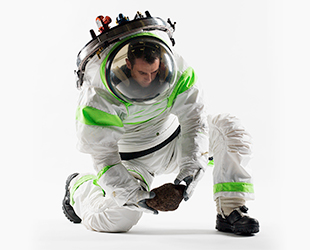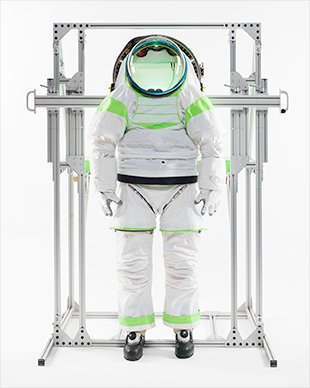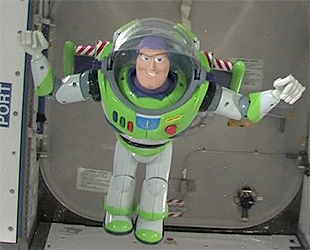December 21, 2012 – What do you get when you cross the historic spacesuit worn by Apollo 11 moonwalker Buzz Aldrin and the futuristic spacesuit 'worn' by Disney-Pixar's Buzz Lightyear?
NASA's prototype Z-1.
The space agency's first new spacesuit to be designed, built and tested in about a decade, the Z-1 features pliable fabrics, a rear-entry "suitport," and — even if unintentional — more than a passing resemblance to a certain animated space ranger.
"We have not built a new flight system since the EMU," Amy Ross, lead of the Advanced Space Suit team, said in a NASA interview, referencing the Extravehicular Mobility Unit developed for the now-retired shuttle program and still used on board the International Space Station (ISS). "The last major prototype we developed was in 1992."
The Z-1, which TIME Magazine named as one this year's best new inventions, is the first step in designing a new spacesuit for NASA astronauts to wear while on missions into deep space, such as to explore an asteroid or to walk on the surface of Mars. Testing of the Z-1 was recently completed at NASA's Johnson Space Center in Houston, where the lessons learned from this first iteration will go into designing the Z-2.

NASA's next generation spacesuit, the Z-1, a prototype of which is pictured at the Johnson Space Center in Houston. (NASA) |
"The goal is by the 2014 to 2015 timeframe to have a new vacuum-compatible exploration-type suit," Kate Mitchell, a spacesuit engineer, said in an interview for the Roundup, JSC's employee magazine. "The Z-1 was developed as a test bed to go and test various technologies and mobility joints so we can further define our [suit] architecture going forward."
To infinity, from behind
One of the new concepts going forward from the Z-1 into the Z-2 is the suitport. Suitports enable spacesuit-wearing astronauts to attach to the back of a rover or pressurized module, as with the Space Exploration Vehicle (SEV) also being developed at NASA Johnson.
"One of the big differences is the rear-entry design," Ross said during a NASA video interview. "So the shuttle EMU splits at the waist and you put pants on and you put the top on separately and they connect in the middle. With [the Z-1], the subject crawls in through the back, and then we just shut the door."

Planned for use by astronauts as they travel to new deep-space locations, the next generation suit will incorporate a number of technology advances to shorten preparation time, improve safety and boost astronaut capabilities during spacewalks. (NASA) |
Creating a back-entry suit solves a few of the problems spacewalkers often face aboard the space station. Using airlocks to depressurize is a time consuming, exhausting process. By using a suitport, the astronauts won't need to go through an airlock at all. The suit hooks to the outside of the spacecraft using the rear opening and the astronaut simply climbs in and detaches.
"We think it's less prone to injury," Ross said, "especially shoulder injury, which can occur with the shuttle EMU."
Because the suit never enters the spacecraft or rover, it also helps keep the vehicles dust and dirt free. During the Apollo lunar landings 40 years ago, the moonwalkers had to be careful about traipsing moon dust inside, as it could become a hazard to their spacecraft systems and to their health.
The suitport does however, add to the prototype's weight. The shuttle EMU weighs about 100 pounds (45 kilograms), but the Z-1 tips the scales at an unwieldy 158 pounds (72 kg). Even on Mars — where the gravity is one-third that of Earth — those additional pounds could make a significant difference.
Art imitating life that resembles art
The white and fluorescent green Z-1 suit has Disney fans seeing Buzz Lightyear. But it was NASA's moon suits that originally inspired the space ranger's look.

A 12-inch Buzz Lightyear toy figure, seen here floating aboard the space station, is now part of the Smithsonian's collection. (NASA) |
"A big part of his design was based on how the Apollo astronauts looked like," John Lasseter, the animator who created Buzz Lightyear and who is now the chief creative officer at Pixar and Walt Disney Animation Studios, said in a 2008 interview with collectSPACE. "They had their clear helmets on, the little skullcaps, the communication devices and such, and then those white suits."
"So as we started developing 'Toy Story,' his design came very much from that, from those guys. That's why he is primarily white and he has that big, clear helmet and he has a skullcap; it's very much based upon the real NASA astronauts," said Lasseter.
Buzz Lightyear's connection to NASA doesn't end there, though. In addition to borrowing his name from Apollo 11 moonwalker Buzz Aldrin, a 12-inch action figure toy of the animated character flew to the International Space Station for 15 months — from May 2008 to August 2009 — as a part of a NASA-Disney educational partnership.
SPACE.com staff writer Miriam Kramer contributed to this article. For more about the Z-1 next-generation spacesuit, see SPACE.com's infographic.
